MXA RACE TEST: 2019 HUSQVARNA TE300i FUEL-INJECTED TWO-STROKE
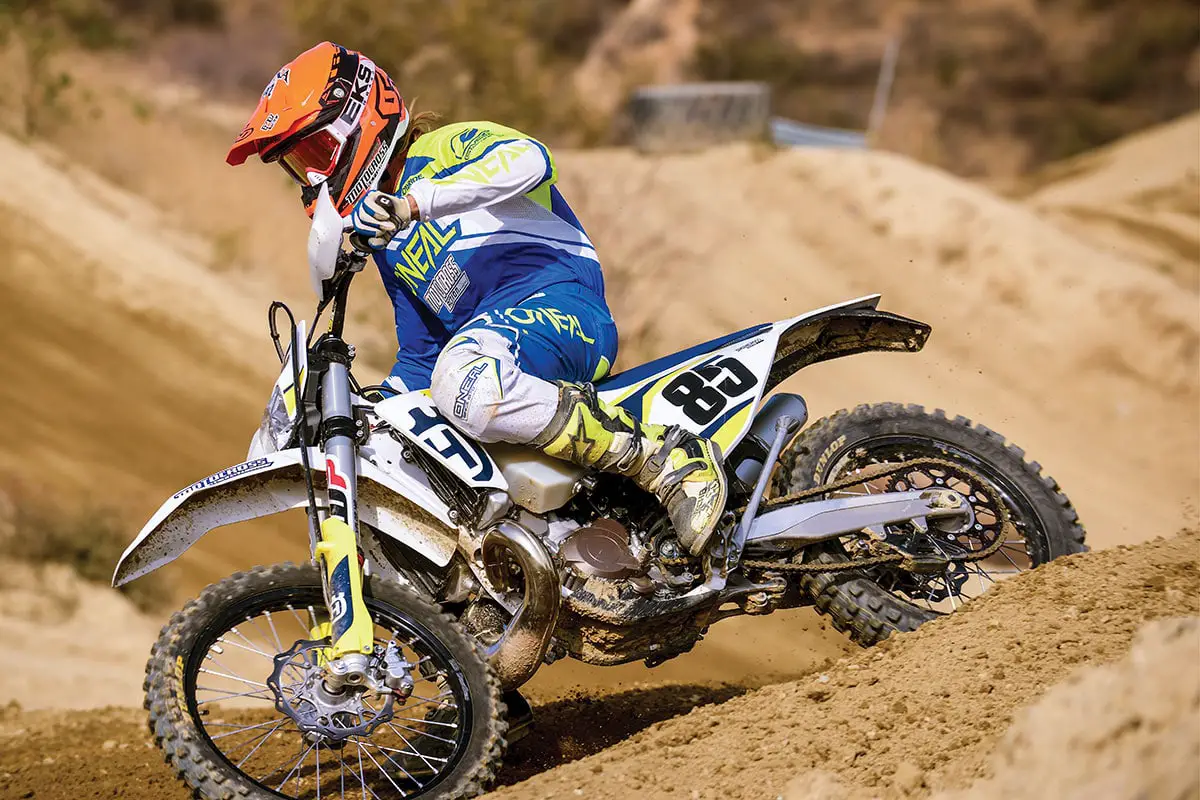
Q: FIRST AND FOREMOST, IS THE 2019 HUSKY TE300i BETTER THAN THE 2018 MODEL?
A: That’s a tough question, because neither Husqvarna nor KTM brought the 300cc version of its fuel-injected two-strokes to America in 2018. Our only experience with the 300 (actually a 293.2cc) was when we rode the Euro-spec 2018 KTM 300XC-W TPI at Erzberg last year. Compared to the 2018 KTM 250XC-W TPI, we liked the 300cc model a lot better. Not that it mattered much, because not only did KTM and Husky not import any 300 fuel-injected two-strokes in 2018, but they only brought in a small pilot program of the 250cc version. Thus, since the 2019 TE300i is a first-year model, it is significantly better than the 2018 model, because there was no 2018 model in the USA.
Q: WHAT’S THE BIG DEAL ABOUT THESE BIKES?
A: Do you like two-strokes? We think you do, because you are reading this test. Realistically, if you’d like to see two-stroke off-road bikes grow, flourish and advance, then you should embrace fuel-injected two-strokes. Without fuel injection being fully developed in the coming years, two-strokes could become obsolete. How do we know? Because it is already happening in Europe. In fact, when the latest European emissions standards were introduced in 2016, KTM had to stop selling its carbureted 125cc two-stroke offroad models. The little two-strokes could not pass the Euro4 emissions test. Worse yet, in 2020, Euro5 legislation will introduce even stricter emissions standards. Those regulations could ban all two-strokes in Europe if the manufacturers don’t make cleaner fuel-injected two-stroke engines. Which is why Husqvarna plans to only sell fuel-injected off-road, TE and TX model two-strokes in 2020.
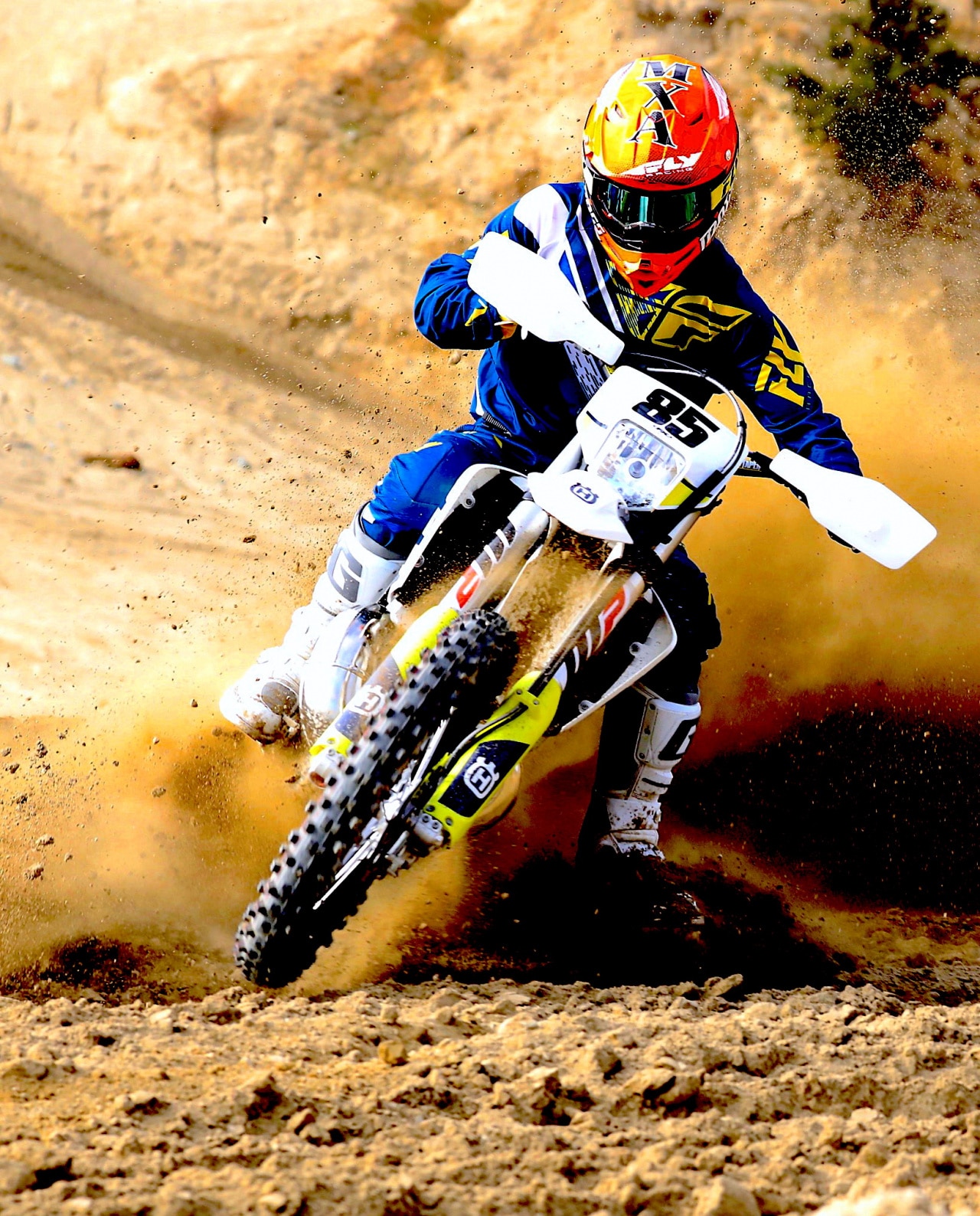
Q: WHAT MAKES A FUEL-INJECTED TWO-STROKE RUN?
A: KTM and Husqvarna fuel-injected two-strokes are transfer port-injected (TPI) engines. No need to change main jets, needles or pilot jets. There is no carburetor. The TE300i’s 39mm throttle body is made by Dell’Orto and does not spritz fuel; however, it does meter air flow through a butterfly valve and serves as the entry point for the auto-lube oil injection. The Engine Management System (EMS) is the brain of the bike and was designed by Synerject. The EMS’ super-fast processor depends on six sensors to collect data. The sensors are as follows: (1) roll-over sensor (that recognizes when the bike is laid down and shuts off the engine within 10 seconds); (2) crankcase pressure sensor; (3) engine-speed sensor; (4) throttle-position sensor; (5) coolant-temperature sensor; (6) intake air-temperature sensor.
If the TE300i doesn’t get its fuel from the throttle body, where does it come from? There are two lateral fuel-injector nozzles, one on each side of the cylinder, that inject fuel into the transfer ports (bypassing the intake tract and crankcase). The EMS uses its data feed to tell the injector nozzle when to spray, how much to spray and how long to spray. Because the fuel is spritzed into the transfer ports just as the supplied air is rushing up the transfer ports, the fuel and air are fully misted when the mixture gets to the combustion chamber.
Fuel-injected two-strokes do need pre-mix; they just don’t need it mixed in a 5-gallon can. On the TE300i, the oil and gas are mixed on the fly. The gas tank is filled with straight 91-octane or better pump gas. The TE300i’s premix oil is located in a 700cc oil tank that is mounted under the gas tank. There is a filler cap behind the steerer stem. It allows the oil tank to be filled via a flexible tube that runs inside the frame’s backbone and into the oil tank. From this tank, the oil is injected at a 70:1 to 100:1 premix ratio. The oil in the tank will last anywhere from four to seven tanks of gas before it needs refilling. If you forget to add oil, an idiot light will come on to warn you.
Q: HOW DOES THE 2019 HUSQVARNA TE300i RUN ON THE DYNO?
A: A dyno is just a tool that helps explain what you feel from the seat of your pants. With the TE300i, the dyno and the test riders’ feelings were in agreement. First, every test rider felt that the TE300i was fast and made its best power in the top-end. Peak power on the TE300i was 49.77 horses at 8600 rpm. That is 2.6 horsepower more than the peak of the 2019 TE250i. If you are trying to choose between a TE300i and a TE250i, the larger 72mm piston is almost 1 horsepower stronger at 6000 rpm, 7000 rpm and 8000 rpm, before jumping up to 2.6 horses more at 8600 rpm.
Unfortunately, every MXA test rider had one complaint about the TE300i powerband. In short, it didn’t rev quickly, accelerate rapidly or run cleanly off the bottom into the middle. When asked to describe how the TE300i ran, test riders said, “Wah, wah, wah, vroom.” It was doggy down low and then took off like a scalded cat. This changed our approach to riding the bike. We had to live with the slow low-to-mid transition and then make the most of the mid-and-up missile. It wasn’t end-of-the-world bad, but it wasn’t perfect by a long shot.
The dyno chart of the 2019 TE300i showed that power climbed steadily from 5500 rpm to 7000 rpm and then flattened out. The dyno dip lasted for an 800-rpm segment of the powerband. The dip at 7000 rpm to 7800 rpm was located directly in the working part of the TE300i’s powerband. Not surprisingly, the dyno chart showed that after 7800 rpm, the dyno curve rocketed upwards on a vertical line that any engine would envy. It went from 43 horsepower to a hair under 50 horses in less than 1500 rpm. That is a kick in the pants.
Q: HOW TO FIX THE POWERBAND OF THE 2019 HUSQVARNA TE300i?
A: We loved the top-end power and tried to find ways to skip over the tamped-down middle. No test riders liked that the power built slowly and then hit the afterburners when there was only 1500 rpm left until it reached (and it signed off completely) 9600 rpm. Our prime objective was to move the power to where we could get the most use out of it.
(1) Gearing. The easiest way to jump over a laggardly low-to-mid transition is to gear it down. Stock gearing is 13/50 on the TE300i. We went to a 51-tooth rear sprocket. Obviously, the six-speed offroad gear ratios were bound to have some holes where the next gear was too tall to pull as hard as most test riders would have liked. The mindset we used was to forget about first and sixth and think of the TE300i gearbox as a four-speed. We feel lucky to have the American version, because the European spec TE300i has 14/50 gearing, which is approximately three teeth taller than the U.S. model. Talk about big gaps between gears.
(2) Airbox. Husky’s signature closed-off airbox restricts airflow. Drilling holes in the airbox gave us more bottom-to-midrange power.
(3) Maps. The handlebars house a two-position map switch. The maps are stock (one hash mark) and mellow (two hash marks). We ran it on map one at all times.
(4) Throttle cam. Switch from the stock, gray, slow-turn throttle cam to the optional, black, quick-turn throttle cam. It makes the engine feel peppier.
(5) Exhaust pipe. Pro Circuit has a pipe for the TE300i and 300XC-W TPI that fills in the dip at 7000 rpm and kicks in a couple of added horsepower on top in the bargain.
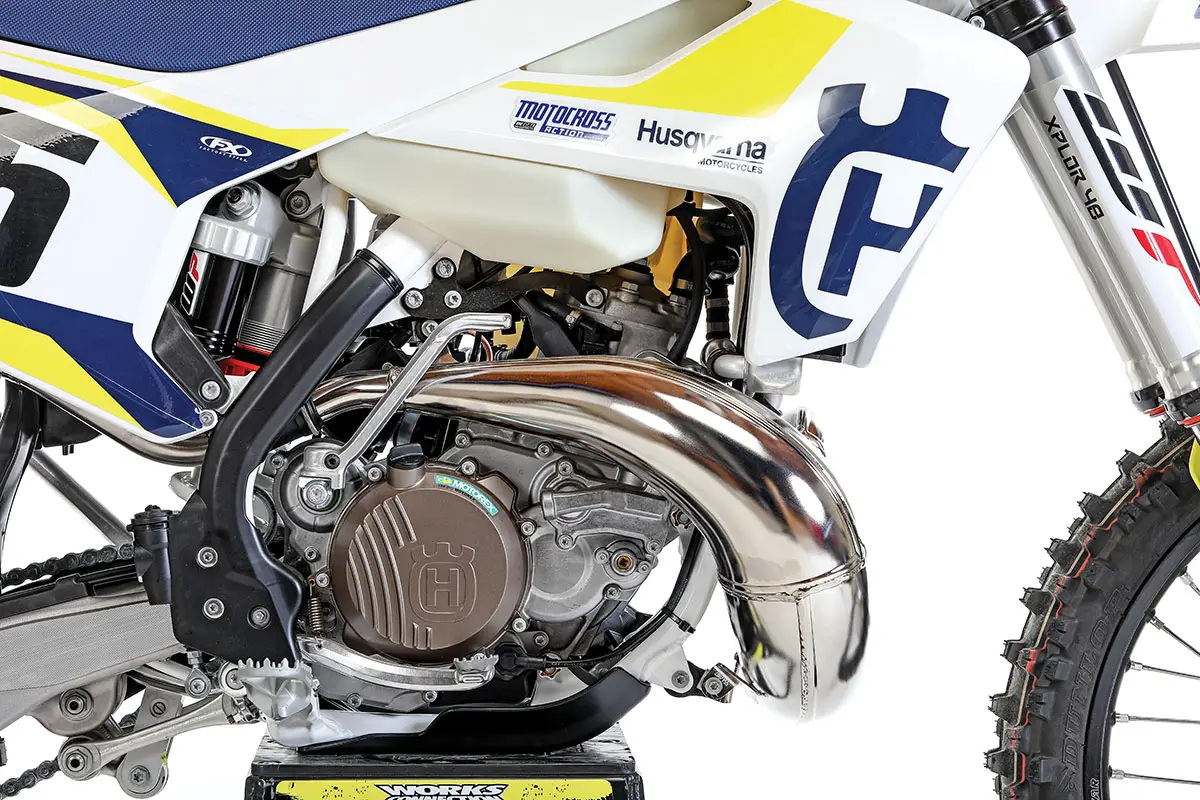
Q: HOW DID IT WORK ON THE TRACK?
A: It should be stated that we weren’t interested in the TE300i’s offroad prowess. We didn’t care how well it plunked over rocks or idled up twisty trails. We appreciate those things, but our eyes were on the prize, which is the day when there will be fuel-injected, two-stroke motocross bikes. We approached the 2019 TE300i as a dual-purpose bike—an off-road enduro machine that could be ridden on a motocross track with your buddies. We had no delusions about the 300i’s capabilities on a modern motocross track, so we weren’t surprised when the majority of test riders pooh-poohed the TE300’s motocross credentials. They were 100 percent correct. The 48mm WP Xplor coil-spring forks were painfully soft. We knew that would present problems on big jumps, but our biggest issue was that they dove so rapidly under hard braking that the chassis went haywire with oversteer. The rear shock, which on the TE300i is fitted to a rising-rate linkage system (while the KTM 300XC-W TPI uses the old-school, singled-sided, no-link, PDS shock system), felt like it was too stiffly sprung. It is, but only because the forks are so under-sprung. The result is a bike that is way out of balance.
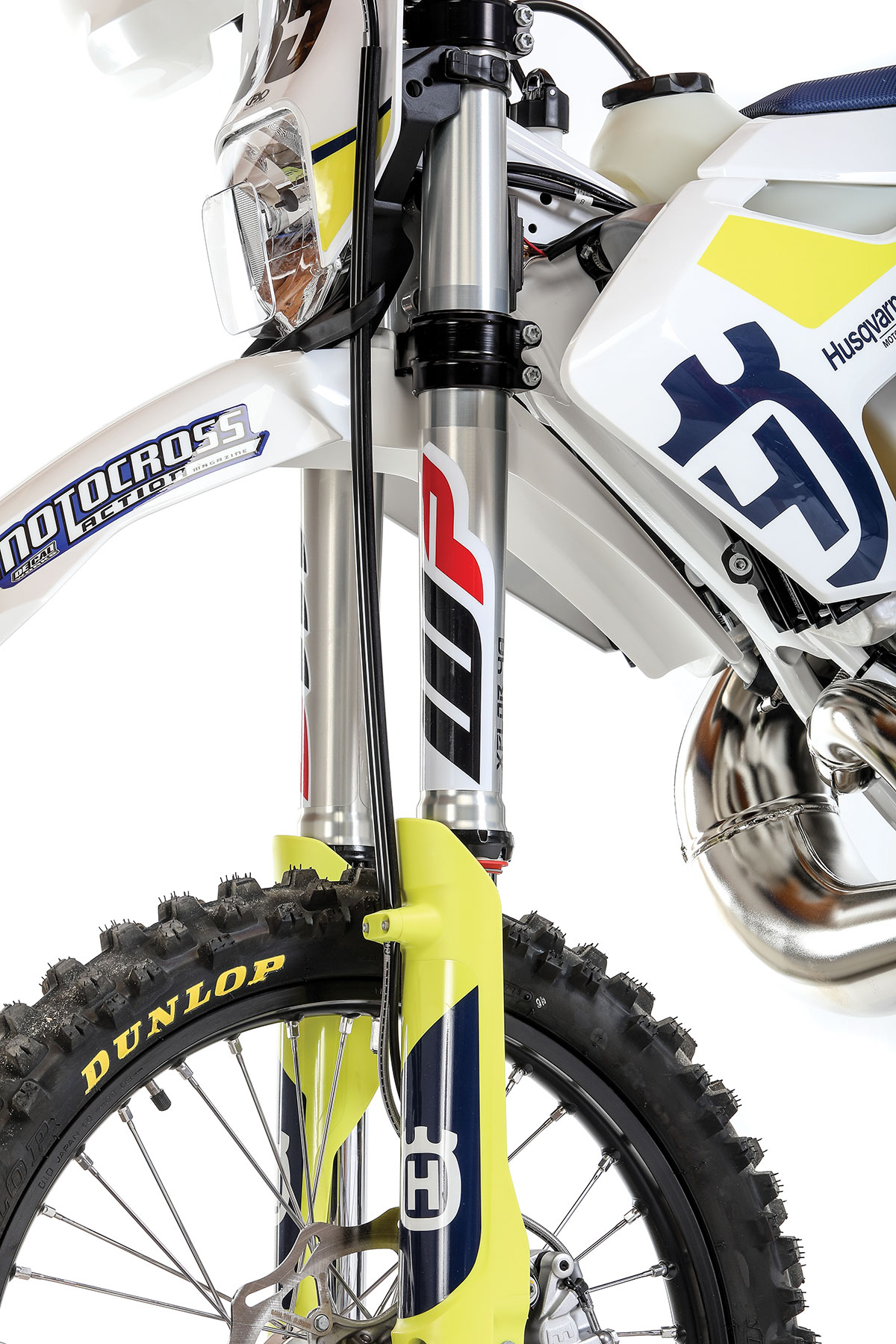
We ran the compression clickers all the way in and cranked the external fork-spring preload adjusters to their stiffest setting, but it was never going to be a viable solution. What shocked us was that our fastest test riders could turn decent lap times on the TE300i, while our Vet and slower test riders struggled mightily. This proved that a skilled rider could back off, smooth out and finesse his way around a motocross track on the weirdly out-of-whack TE300i chassis, but a less-skilled Vet just hacked everything up.
Although it goes against our nature, we aren’t going to tell you to buy a TE300i and spend beaucoup bucks on exhaust pipes, port jobs, ECU mapping, stiffer fork spring, 19-inch wheels, gearbox ratios and stripping off all the enduro foof to turn it into a motocross bike. Don’t do that. This bike, apart from its out-of-balance setup, is designed to do something that makes it almost incapable of doing the thing we love (motocross). It is a good enduro bike and a compromised motocross bike. In 2020 Husqvarna will offer a TX300i version of the TE300i and it will be much closer to the mtocross model than the 2019 TE300i—wait for it.
If you want a 300cc Husqvarna motocross bike, buy a TC250 and install the TE300 cylinder, head, piston, power valve parts, gaskets and black box (or get on the long waiting list to get a PowerParts 300cc kit—available in both motocross and offroad tunes). No, it won’t be fuel-injected, but it will be a great big-bore two-stroke ’crosser.
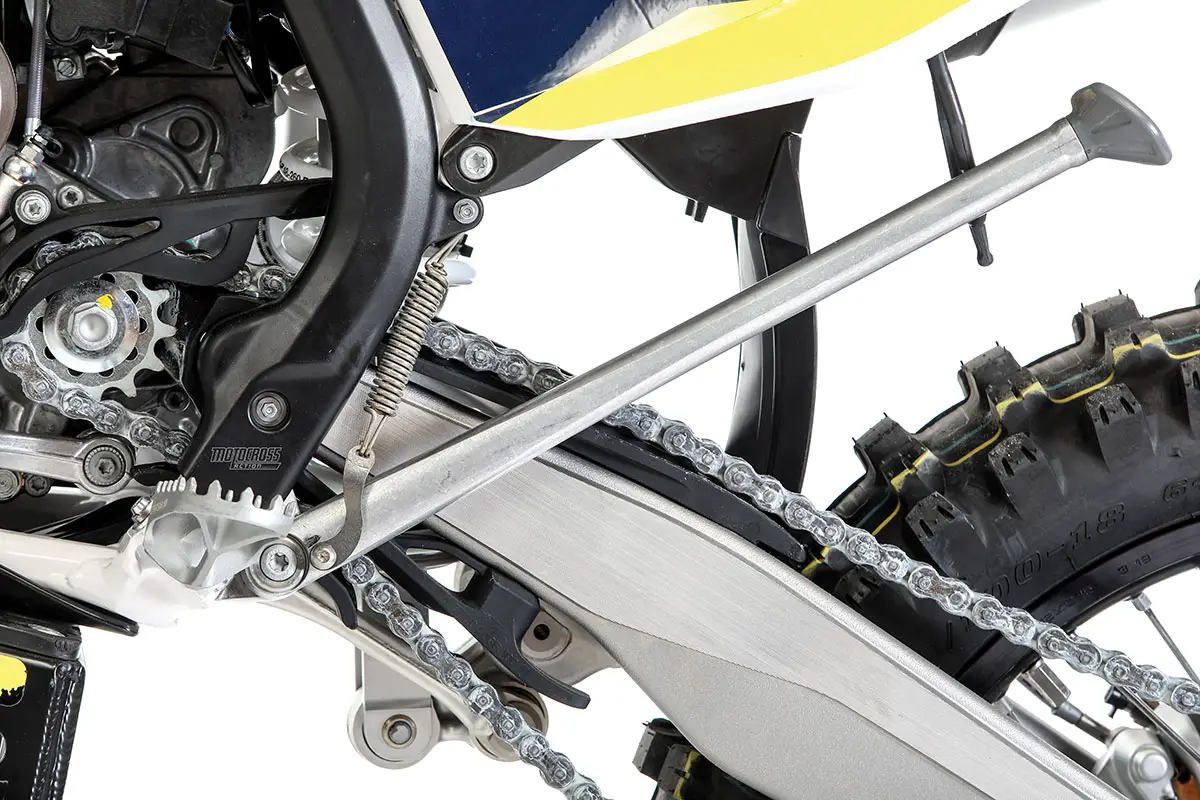
Q: WHAT DID WE HATE?
A: The hate list:
(1) Height. The 2019 Husqvarna TE300i is too tall for a motocross bike, so you know it is skyscraper tall for an offroad bike.
(2) Maps. Map 2 was horrible, and map 1 had a big hole in it at 7000 rpm. As it sits, this bike doesn’t need a mellow map to partner with the stock map; it needs an aggressive map.
(3) 18-inch rear wheel. We honestly believe that most non-Pro motocross racers would be better served by the cushier 18-inch rear tire and its larger contact patch, but the tire companies have put all their eggs in the 19-inch basket. As an enduro bike, the TE300i gets Dunlop Geomax AT81 tires and an 18-inch rear wheel.
(4) Oil tank. Last year our oil tank leaked in the workshop. Husqvarna has fixed this for 2019. We never wait for the idiot light to come on.
(5) Pre-mix oil. You must run two-stroke oil that is billed as “oil-injector compatible.” Injector oil has a much thinner viscosity to allow it to be pumped through tiny injector nozzles without clogging them.
(6) Powerband. The best power is in the upper stratosphere of the rpm range, but waiting for it to arrive is frustrating.
(7) Chassis. Offroad models tend to run a full model year behind the motocross bikes. The 2019 TE300i doesn’t have the latest-generation frame, plastic or accoutrements. It is still last year’s bike.
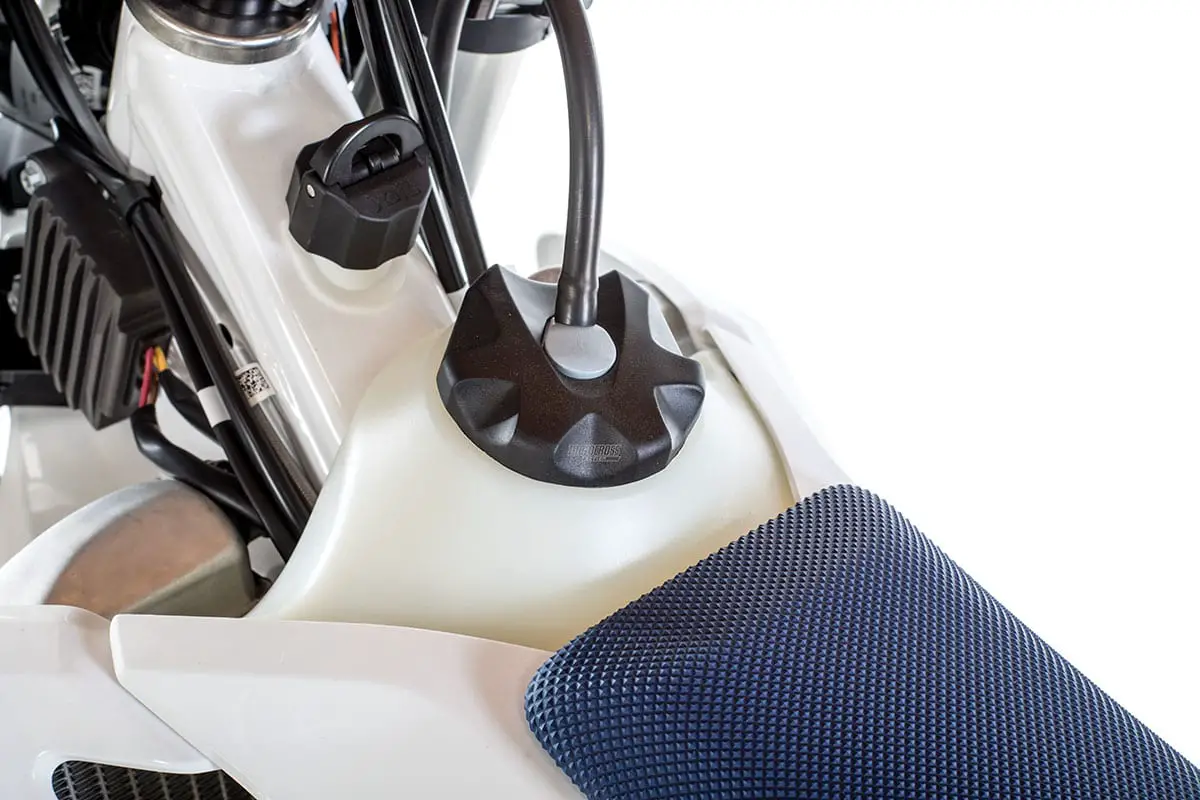
Q: WHAT DO WE LIKE?
A: The like list:
(1) Forks. These forks absorb chop like it’s not even there, but the fork springs act like they aren’t there when you start braking hard.
(2) Engine. It cranked out almost 50 horsepower with EFI technology that is barely in its second year of production.
(3) Brakes. Best in the business.
(4) Clutch. Like the FC450 and TC250, the TE300i gets a Magura-activated, rubber-damped steel clutch basket and a Belleville washer-equipped clutch that is bulletproof.
(5) Gas tank. It is pretty awesome that we don’t have to premix gas anymore and can see the fuel level at a glance.
(6) Rear fender grip. The rear fender offers a good handhold for lifting the bike on and off its stand. We wish this feature were on every Husky and KTM.
(7) Chain. As you would expect on an offroad bike, the TE300i gets an O-ring chain or, more accurately, an X-Ring chain.
(8) Electric start. Yeah, yeah, yeah. You don’t need electric start on a two-stroke; it comes with a kickstarter for the stubborn.
(9) Shock linkage. The Husky version of the fuel-injected 300 gets a rising-rate linkage, while the KTM 300XC-W TPI has old-school, no-link PDS rear suspension.
(10) Engineering. The engineers were able to fuel-inject a two-stroke engine with the simple and creative solution of injecting the fuel into the transfer ports where the pressure dynamics of the rotating crank and piston would do most of the work.
Q: WHAT DO WE REALLY THINK?
A: We learned a lot during the test. As an offroad bike, the TE300i has the potential to be a silk purse. Conversely, it is a sow’s ear as a motocross bike. What we don’t know about enduro suspension could fill a book, because we obviously don’t know anything about the subject. What we do know about setting up a bike’s suspension is that the TE300i is out of balance in a big way. Last year we said that we expected Husky’s engineers to “iron out the sluggish low-end powerband,” but we were overly optimistic about that. We thought we would find racing a fuel-injected two-stroke to be different from racing a carbureted one. It wasn’t. It was still gas-and-go. What do we really think? We love this bike. It isn’t the fulfillment of all of our wishes, but this is the two-stroke of the future. Think about what the two-strokes of today were spawned from 55 years ago. The TE300i is a great starting point for the next 55 years.
MXA’S 2019 HUSQVARNA TE300i SETUP SPECS
This is how we set up our 2019 Husqvarna TE300i for racing. We offer it as a guide to help you find your own sweet spot.
WP XPLOR FORK SETTINGS
The stock WP fork settings were designed for offroad use, not high-speed West Coast offroad races, but slower woods and enduro events. For motocross, we went all the way stiff with the forks—and they still weren’t stiff enough. For hardcore racing, we don’t recommend this bike or this fork setup. If you want to race this bike, you are going to have to send the forks out to a qualified tuner. For hardcore racing, this is the best setup for an average rider on the 2019 Husqvarna TE300i (stock specs are in parentheses):
Spring rate: 42 N/mm
Compression (red cap): All the way in (15 clicks out)
Rebound (white cap): 15 clicks out
Fork-leg height: Flush
Notes: There is an adjustable fork spring preload adjuster on the forks. Turn it clockwise to make the forks stiffer and counterclockwise to make them softer. We turned them as far as they would go in a clockwise direction.
WP OFFROAD SHOCK SETTINGS
For an offroad shock, we felt it worked well, but not in conjunction with the overly soft front forks. Stock settings were solid for offroad terrain, but for motocross, we went stiffer on the compression. For hardcore racing, we recommend this shock setup for an average rider on the 2019 Husqvarna TE300i (stock specs are in parentheses):
Spring rate: 48 N/m
Race sag: 110mm (105mm)
Hi-compression: 2 turns out
Lo-compression: 15 clicks out
Rebound: 15 clicks out
Notes: Considering the soft damping, the rear end held up well on hard landings and absorbed chop without any issues. But, the stiff shock spring overpowered the soft fork springs, wreaking havoc on the bike’s handling.


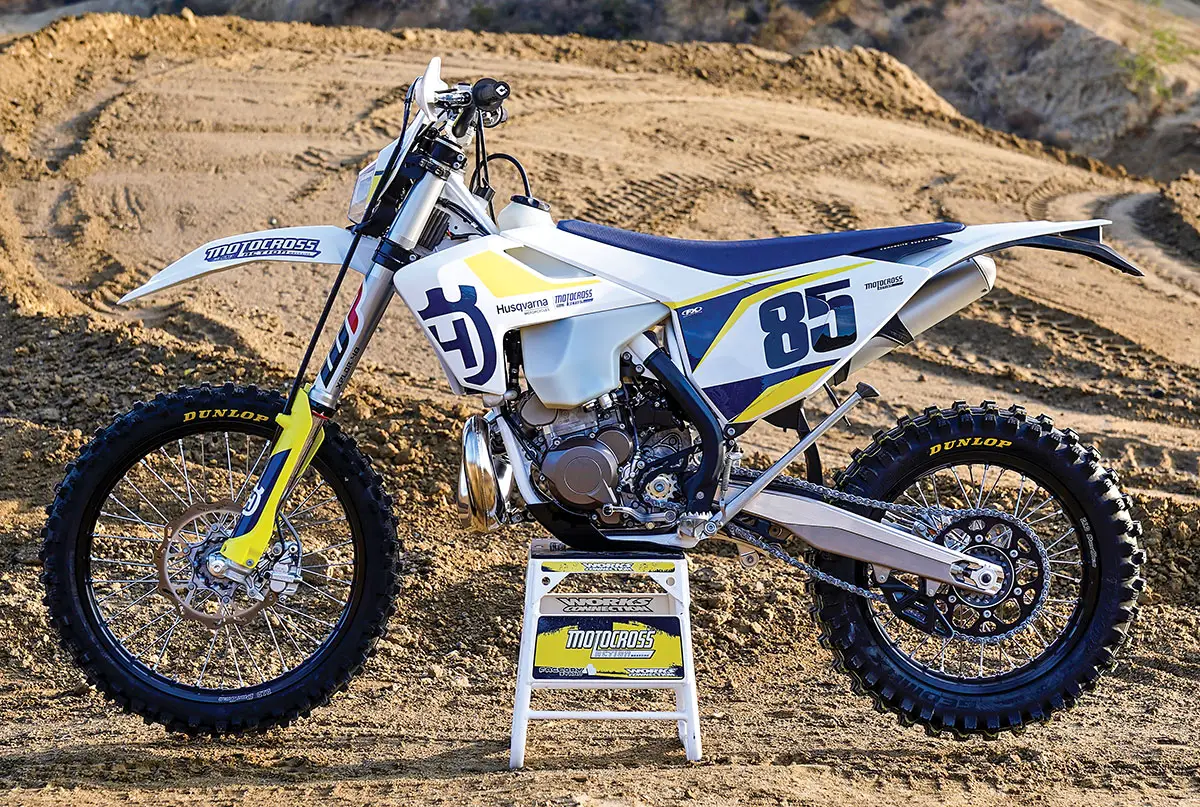
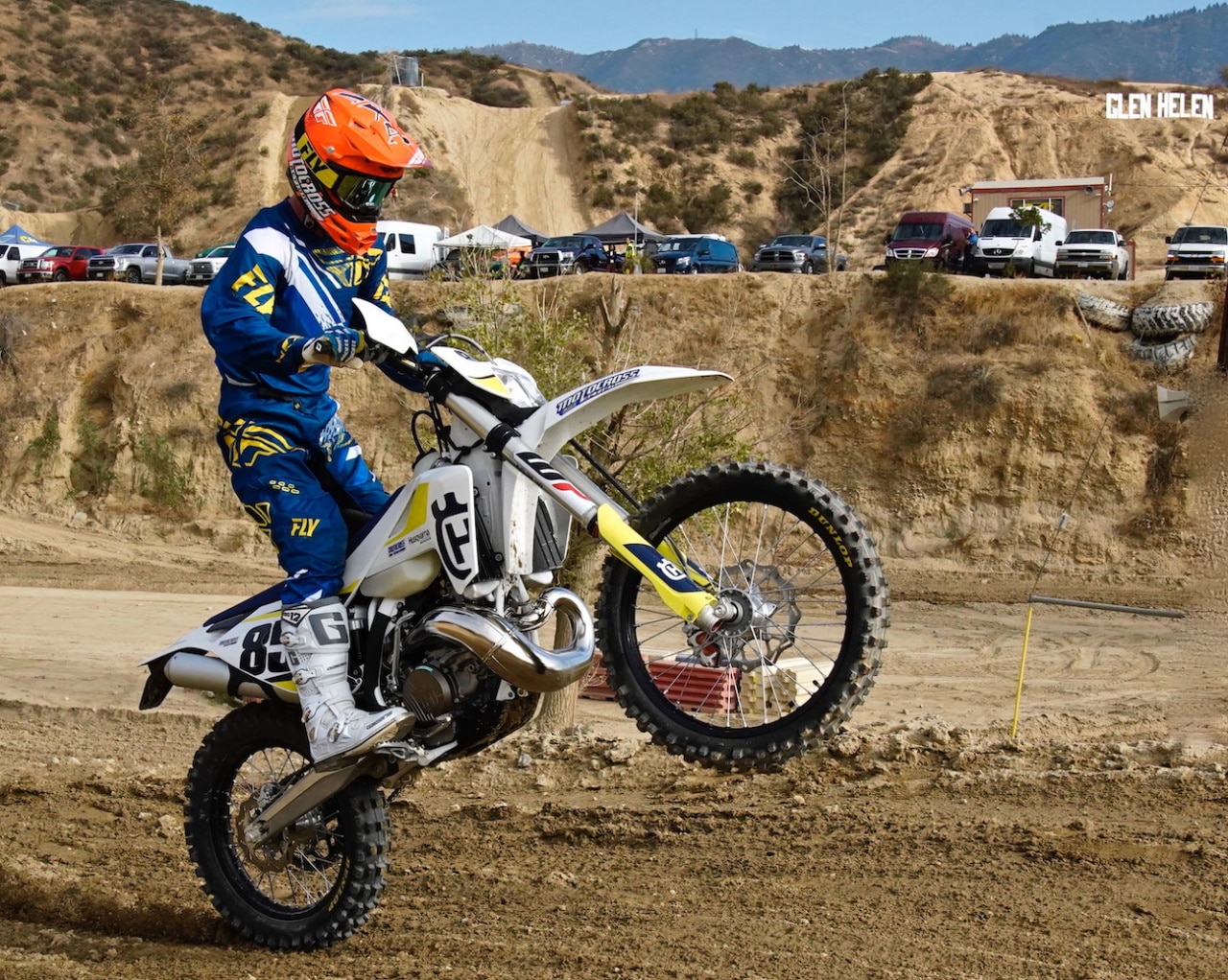

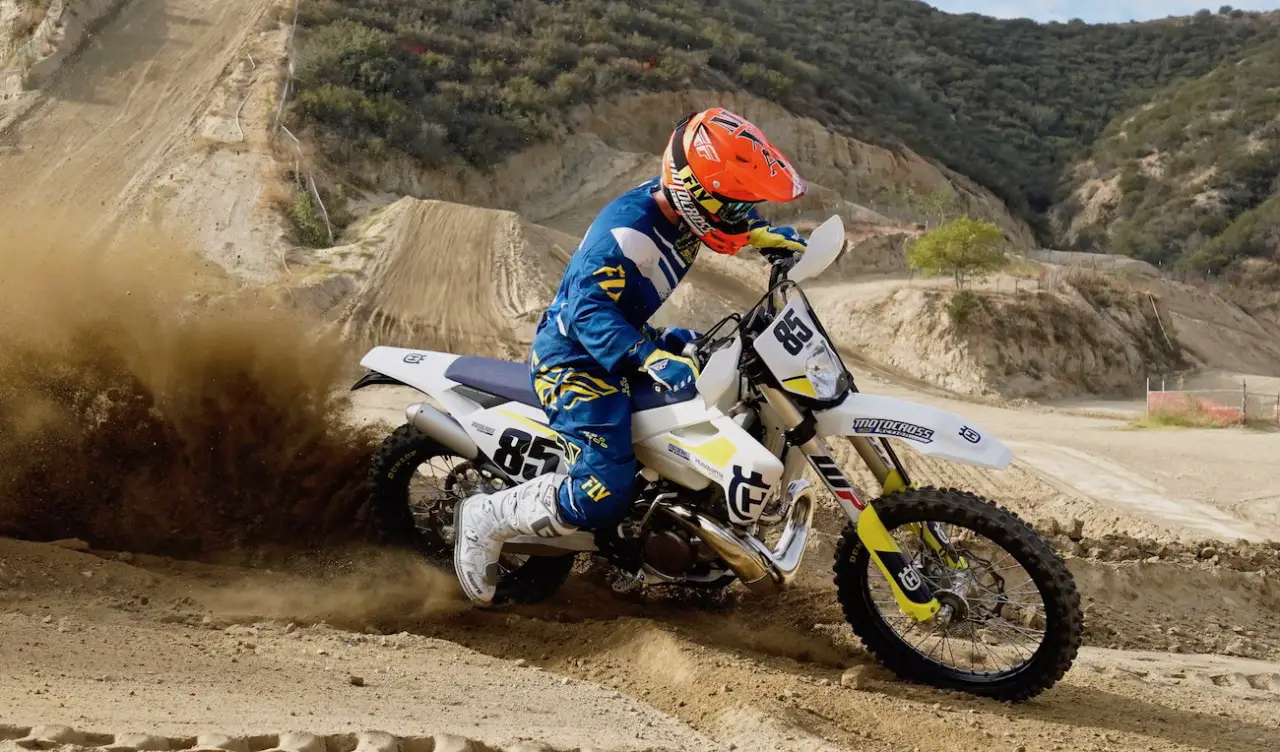
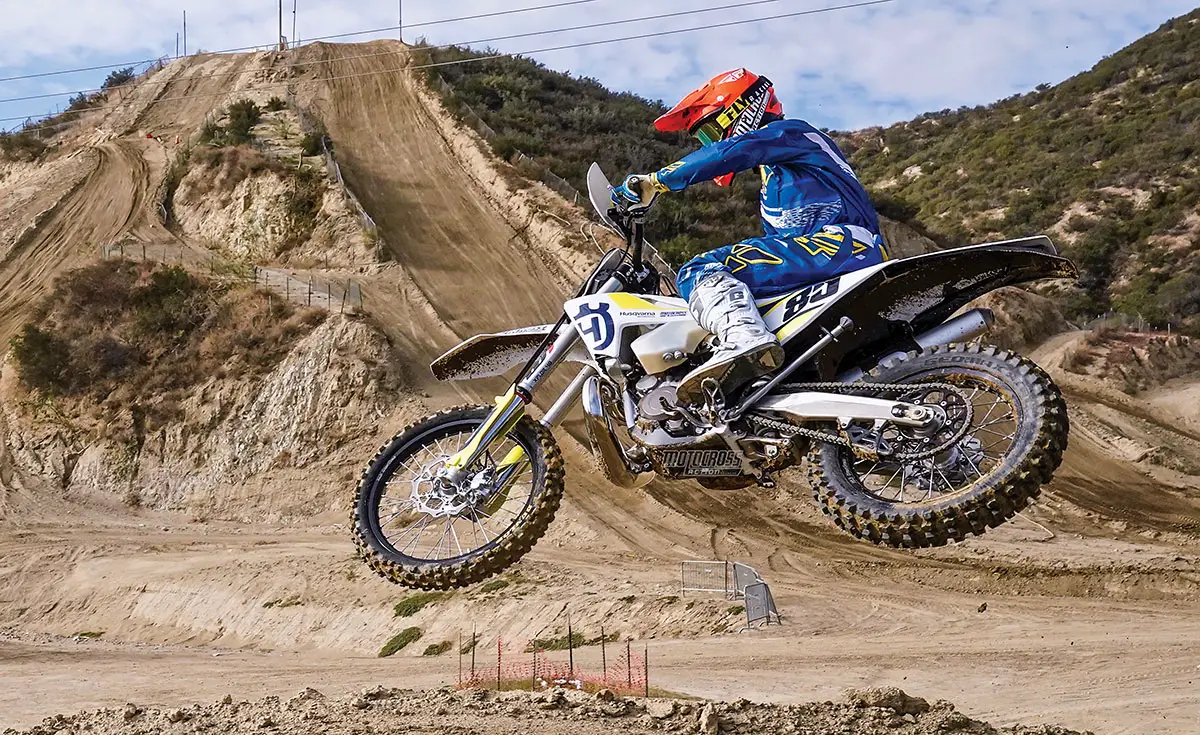



Comments are closed.